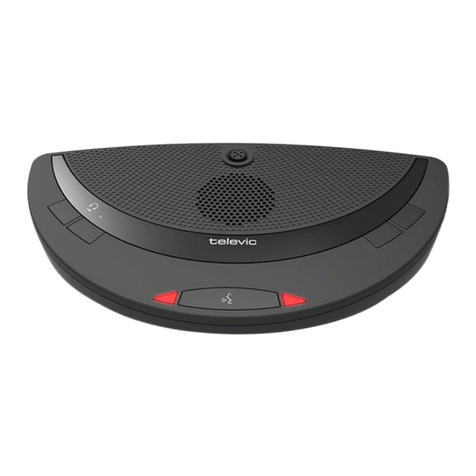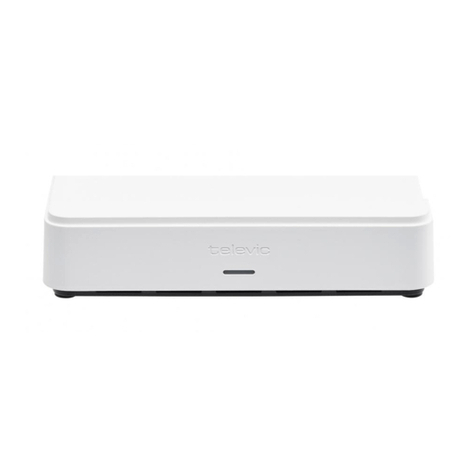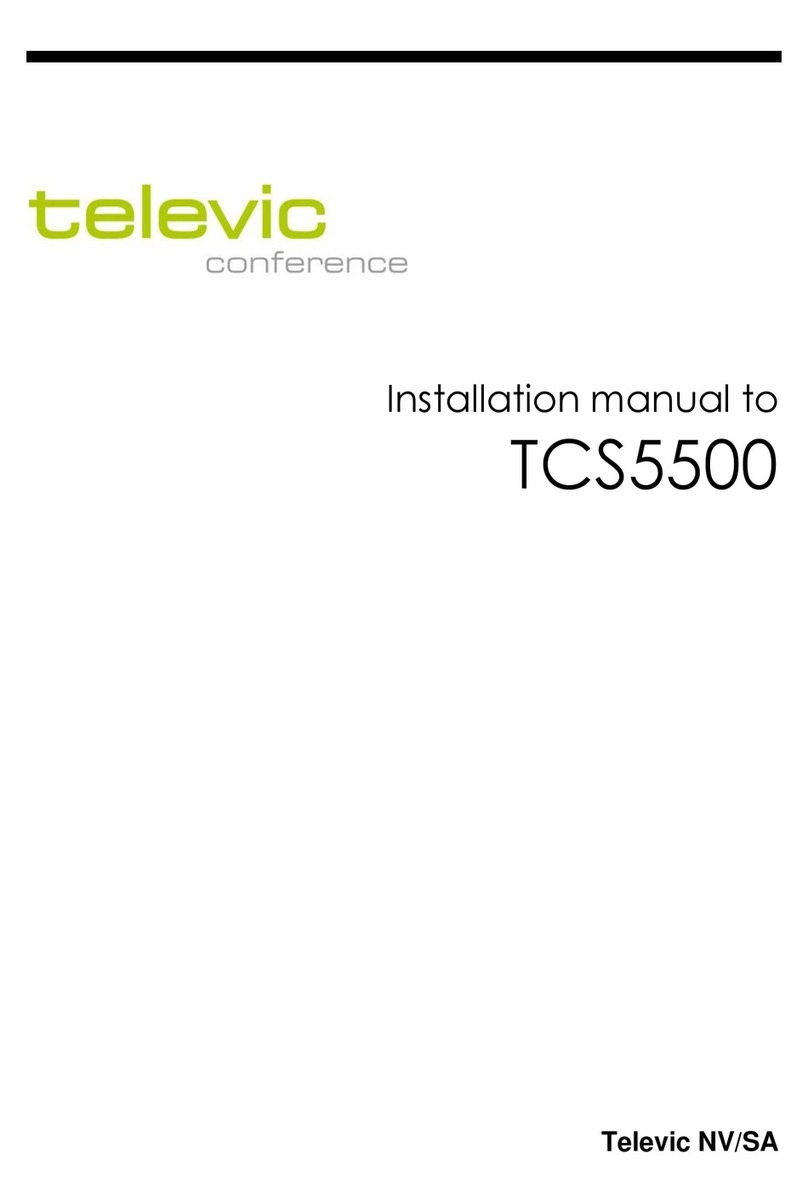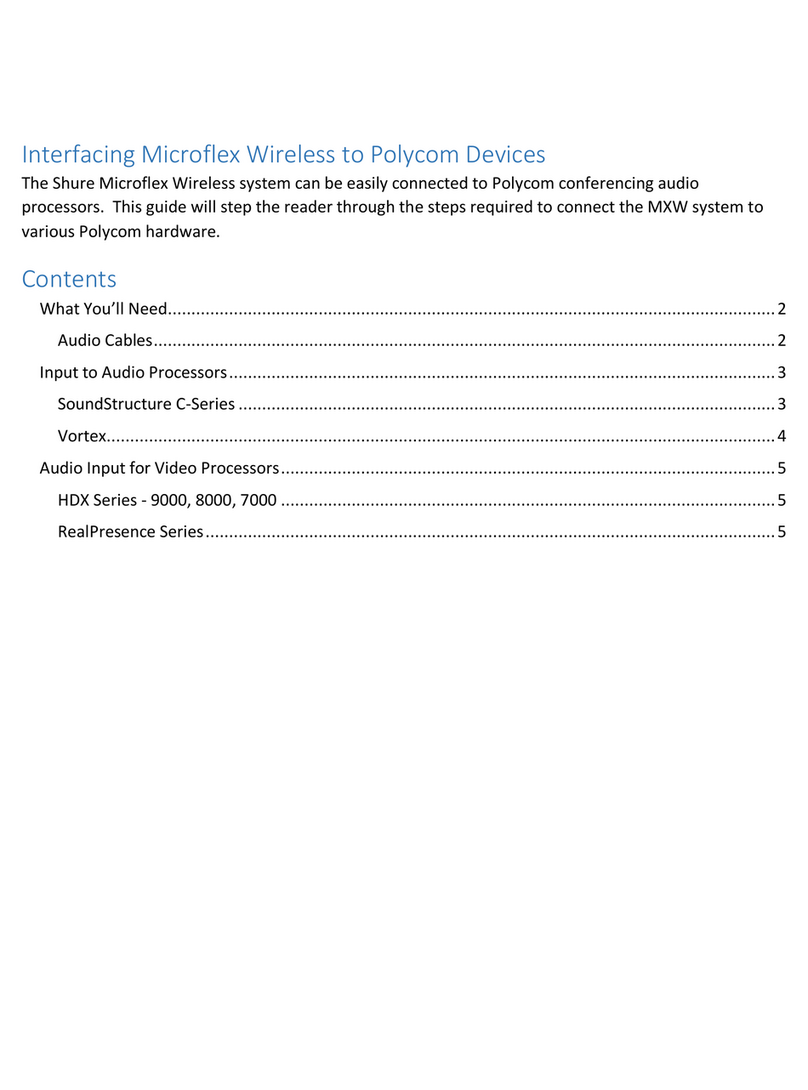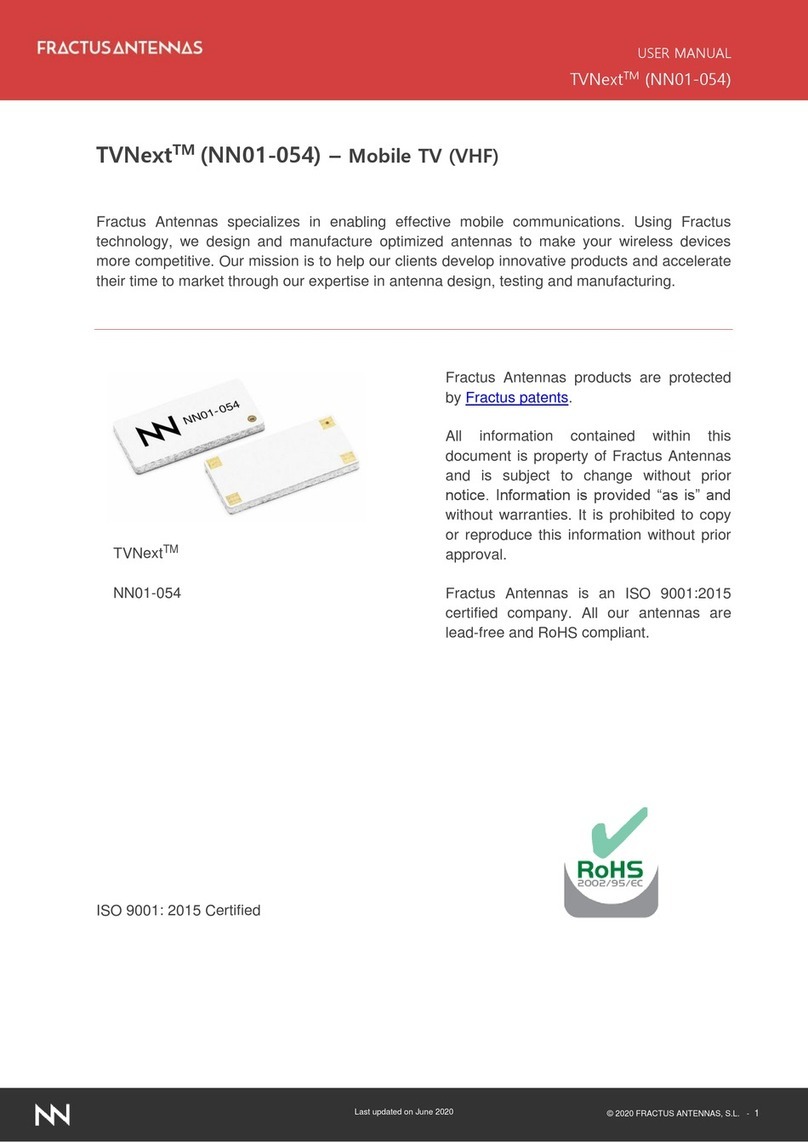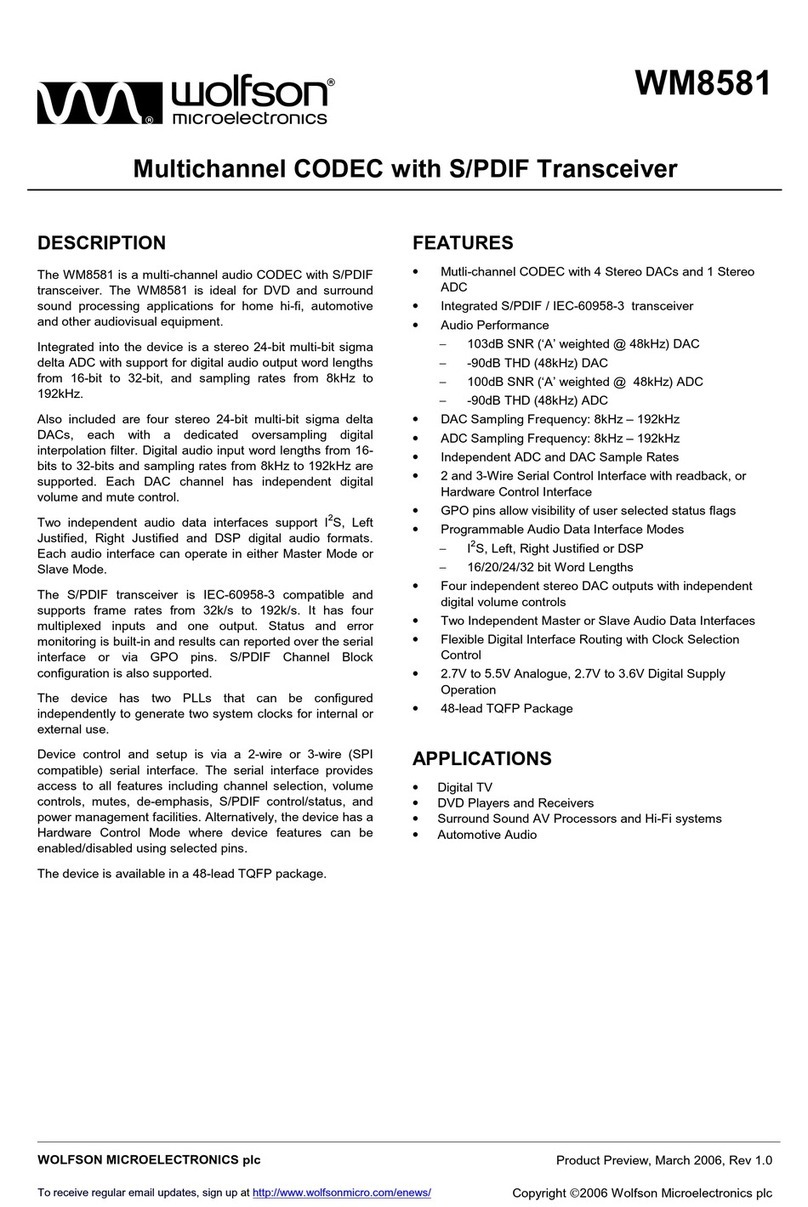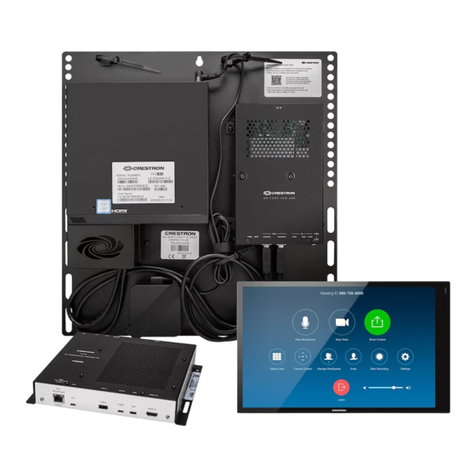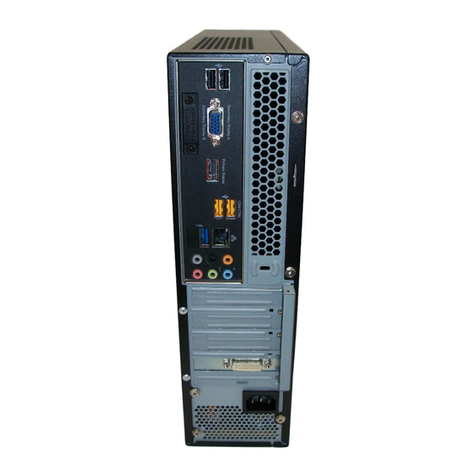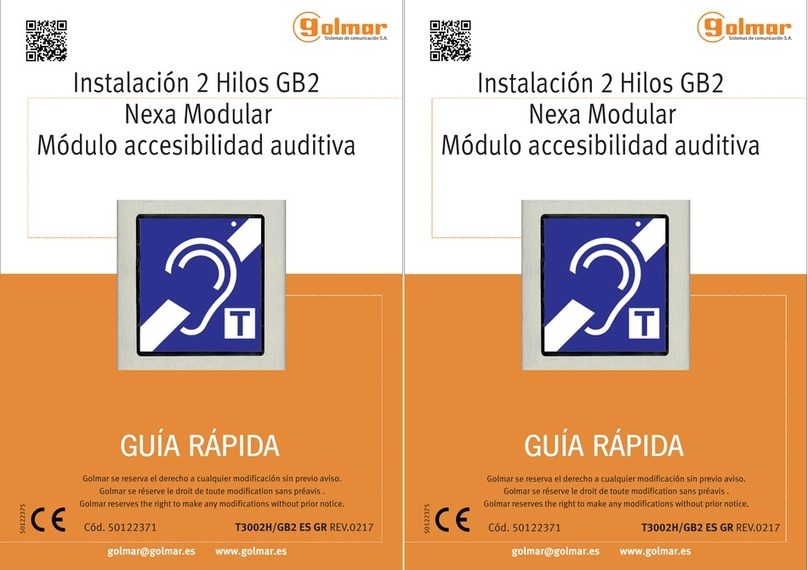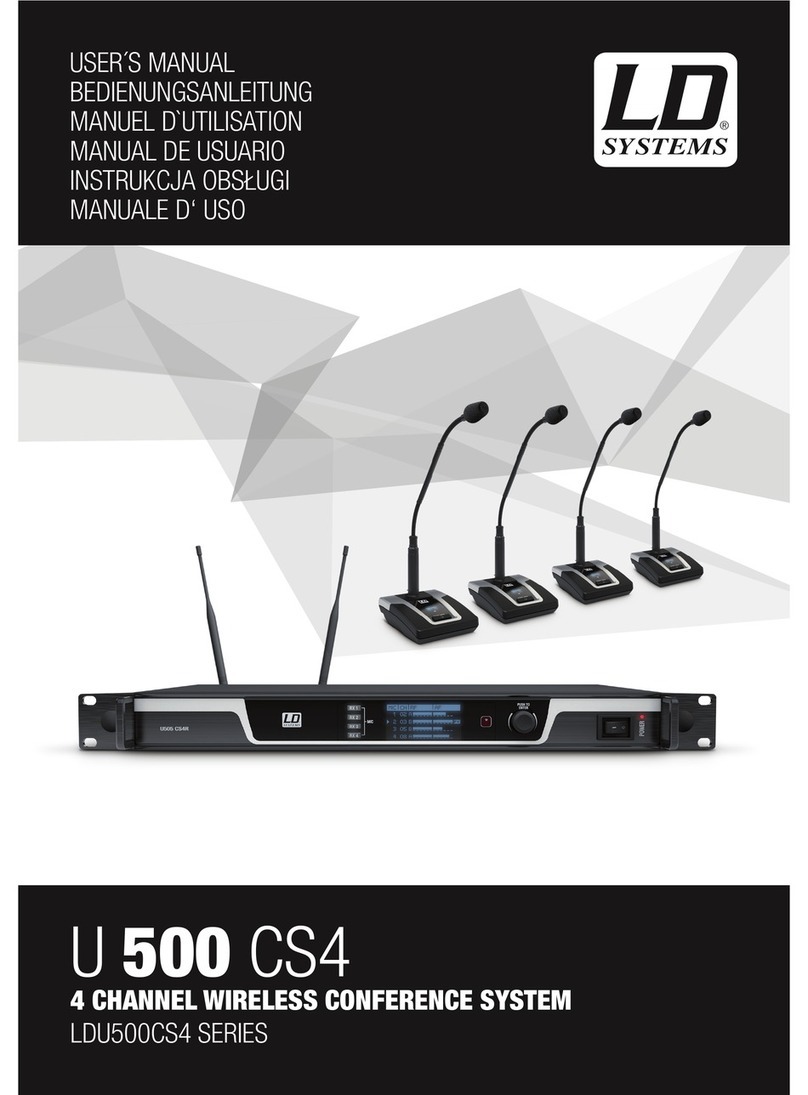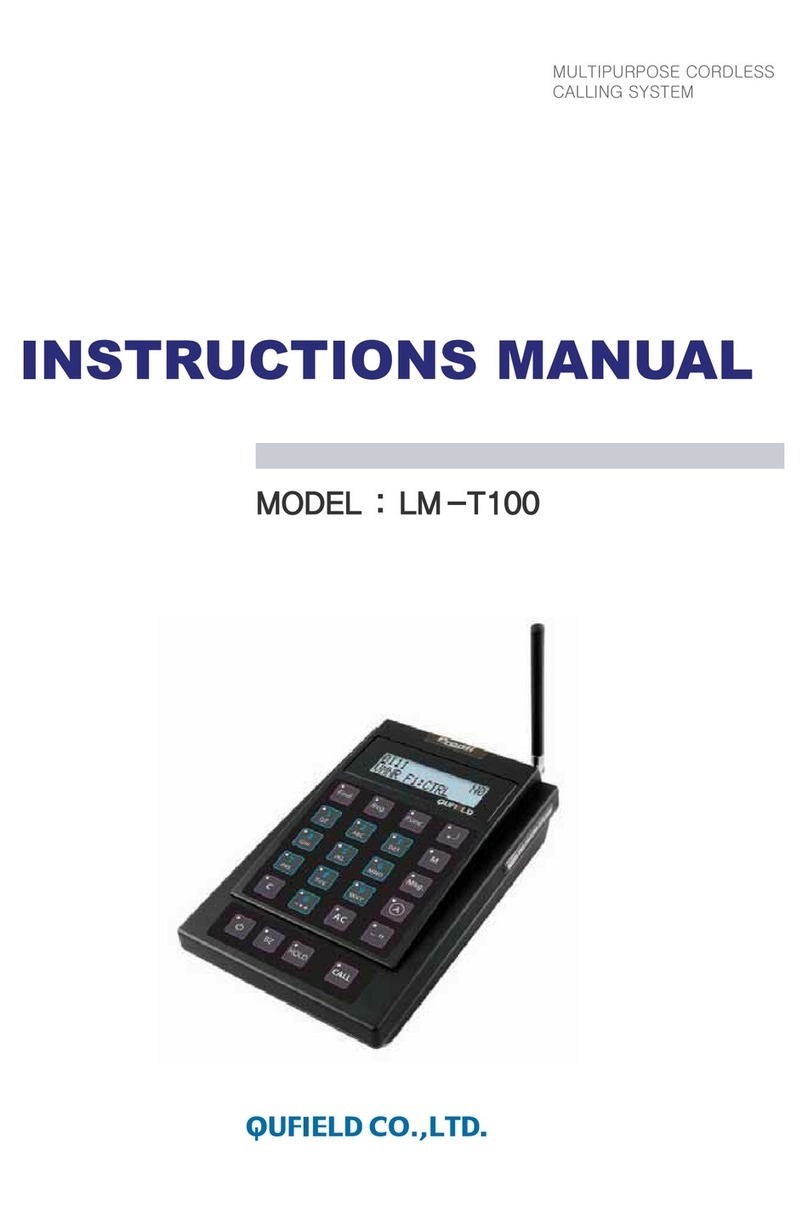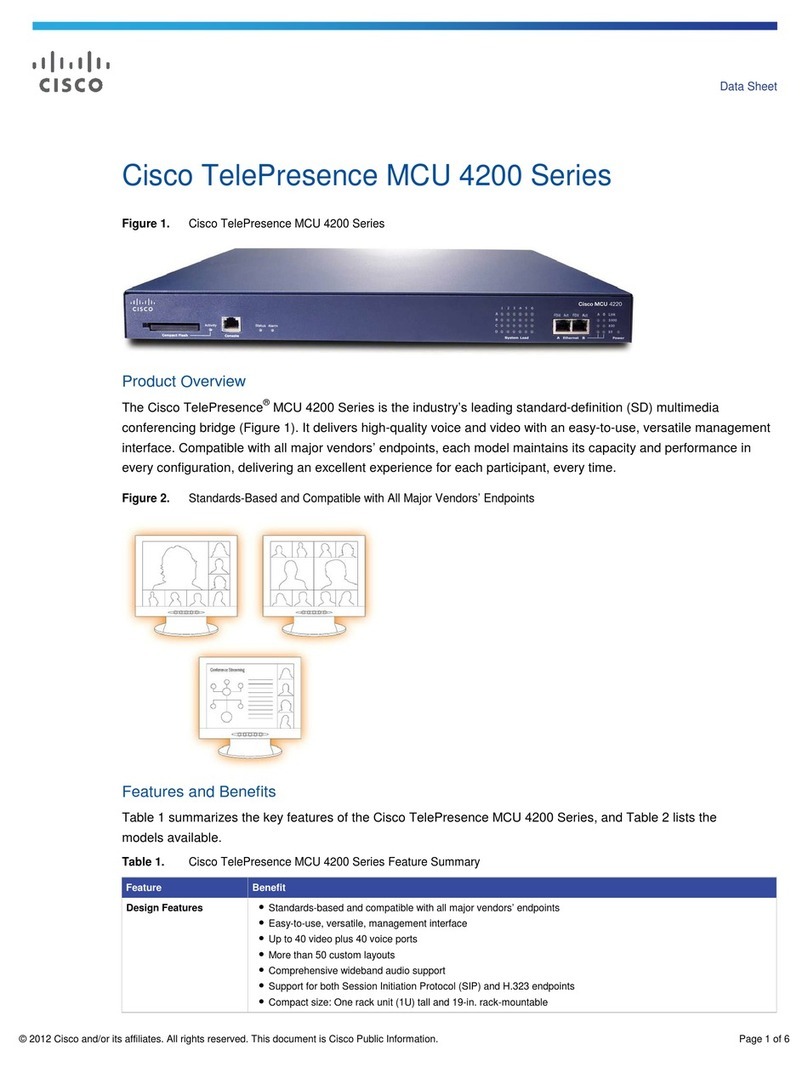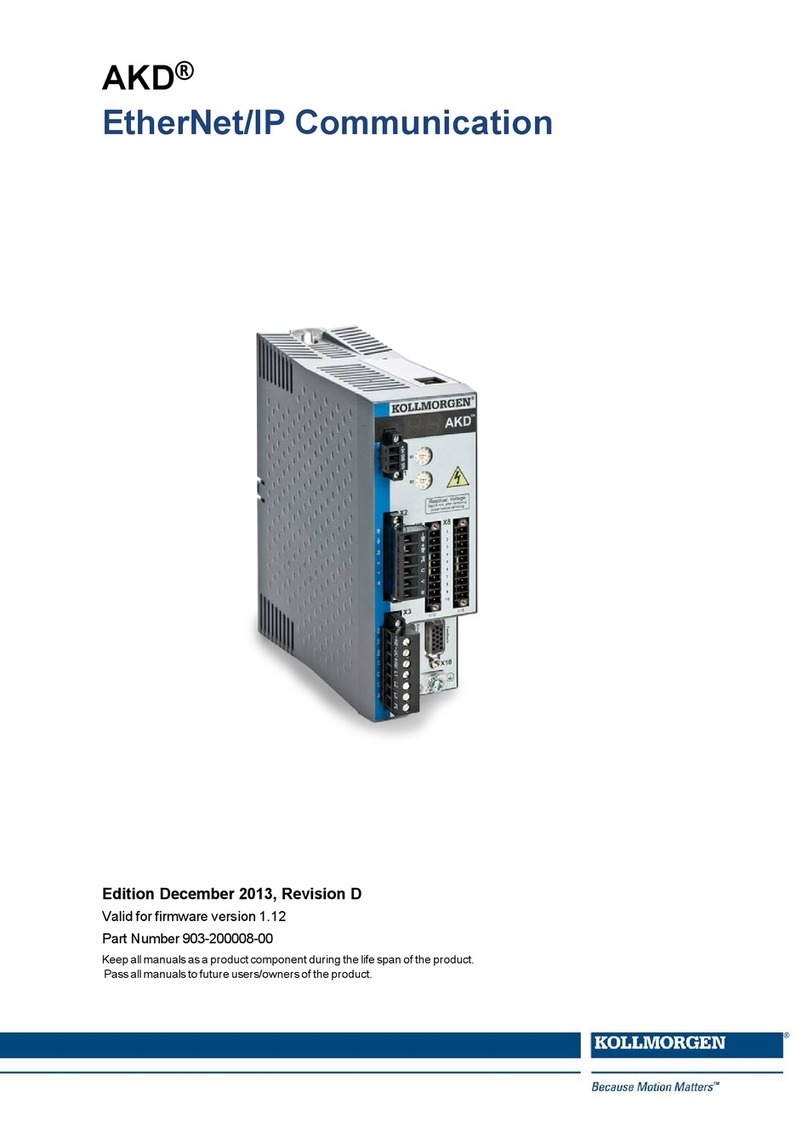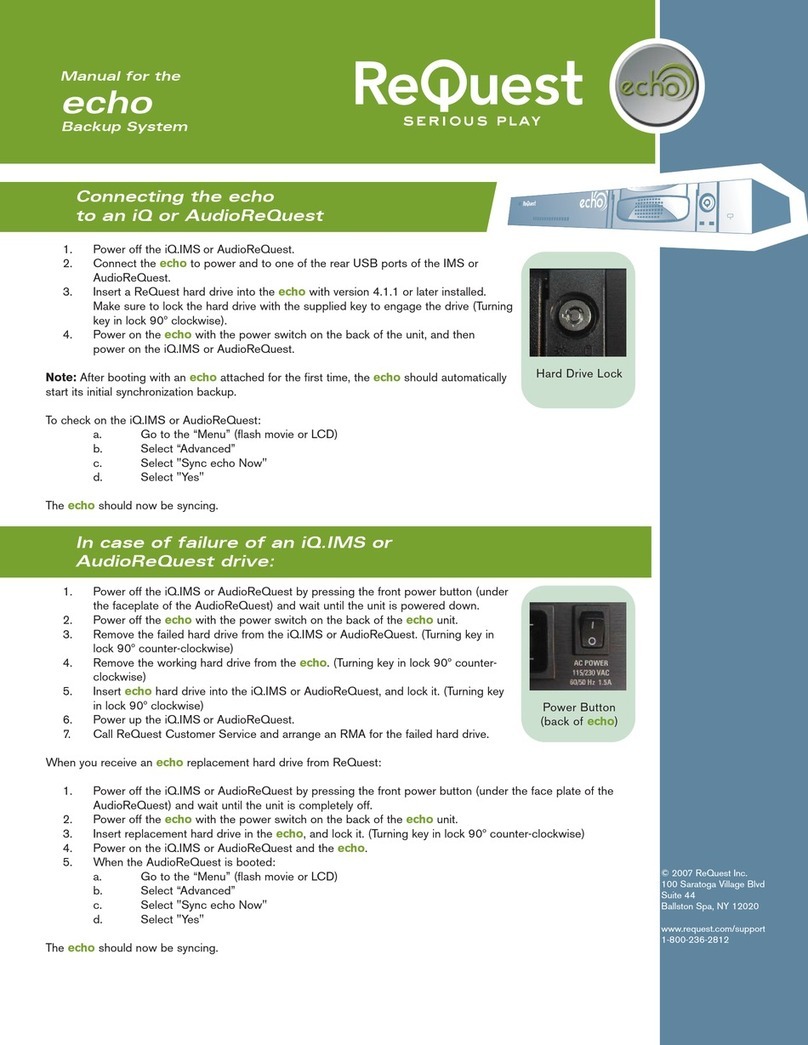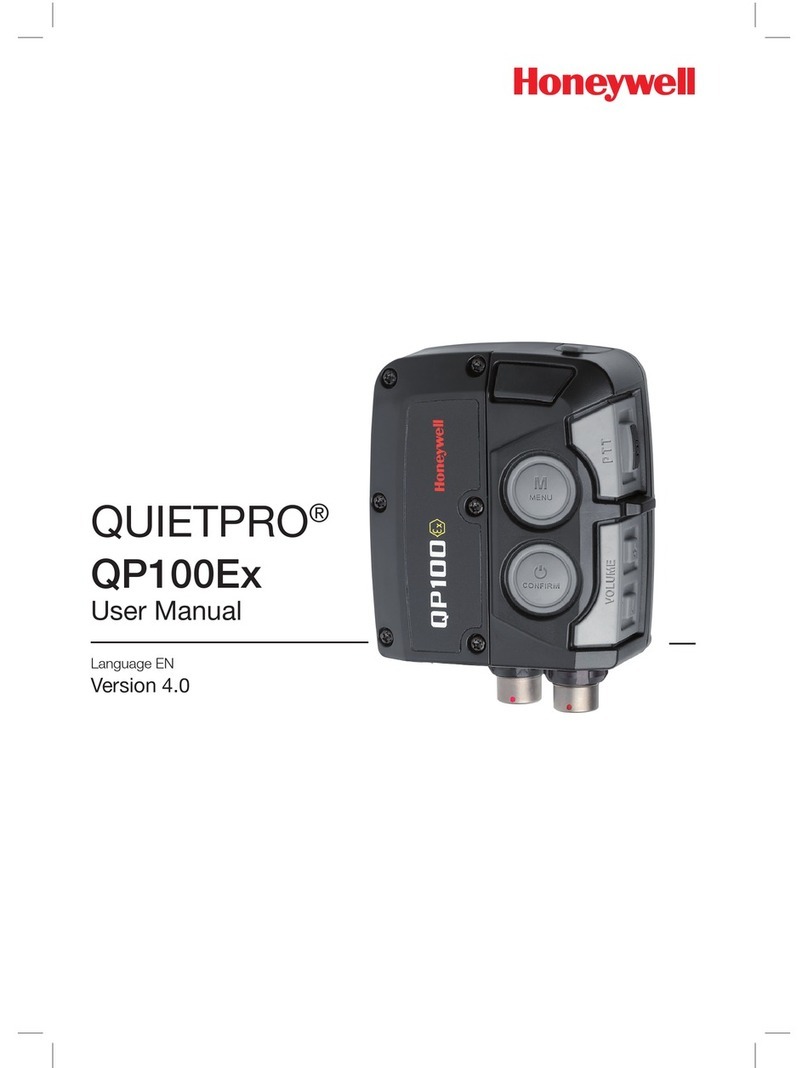Televic Confidea User manual

Confidea
Wireless Conference System
Installation and User Manual

Confidea Wireless System Installation and User Manual
Televic Conference Systems 2012-05-11 2
Table of Contents
Table of Contents ......................................................................................................................... 2
Section 1 – General Information ................................................................................................... 7
1. Copyright Statement ...................................................................................................... 9
2. Trademarks .................................................................................................................. 1
3. Safety Instructions and conformity info ......................................................................... 11
3.1. FCC and ICES information .............................................................................................. 11
3.1.1. Statements for CC and Industry Canada ........................................................................... 11
3.2. Conformity and Certification info for Japan ................................................................... 12
3.3. Important safety instructions ........................................................................................ 12
3.4. General conformity info ................................................................................................ 14
3.5. Power Connections ....................................................................................................... 15
4. Confidea wireless System Information .......................................................................... 16
4.1. General System Architecture ........................................................................................ 16
4.1.1. Components ...................................................................................................................... 16
4.1.2. Stand-alone system ........................................................................................................... 16
4.1.3. Connected to Televic wired conference system ................................................................. 16
5. Wireless networks and frequency bands ....................................................................... 17
5.1. Wireless LAN ................................................................................................................ 17
5.2. Televic Confidea wireless system .................................................................................. 17
5.2.1. requency bands ............................................................................................................... 17
5.3. Frequency Planning ...................................................................................................... 18
5.3.1. Use with Wi i base stations nearby ................................................................................... 18
5.3.2. Use of multiple Confidea wireless systems ......................................................................... 19
5.4. Max range of WCAP ...................................................................................................... 19
5.5. Guidelines on optimal WCAP positioning and direction of antennas ............................... 2
5.5.1. Positioning the Confidea Wireless Access Point ................................................................. 20
5.5.2. Optimizing the position the antennas ................................................................................ 20
Section 2 – System Components .................................................................................................. 22

Confidea Wireless System Installation and User Manual
Televic Conference Systems 2012-05-11 3
6. Wireless contribution units ........................................................................................... 23
6.1. Introduction ................................................................................................................. 23
6.2. Controls and indicators ................................................................................................. 23
6.3. Installation ................................................................................................................... 32
6.4. Maintenance ................................................................................................................ 32
6.4.1. General ............................................................................................................................. 32
6.4.2. Cleaning ............................................................................................................................ 32
6.5. Startup and shutdown .................................................................................................. 33
7. Microphones ................................................................................................................ 33
7.1. Introduction ................................................................................................................. 33
7.2. Electrical and acoustic properties ................................................................................. 33
7.3. Microphone connector ................................................................................................. 34
7.4. Operation ..................................................................................................................... 34
7.5. Installation and handling .............................................................................................. 35
8. Battery Pack ................................................................................................................. 36
8.1. Introduction ................................................................................................................. 36
8.2. Safety ........................................................................................................................... 36
8.3. Controls and indicators ................................................................................................. 37
8.4. Installation ................................................................................................................... 37
8.5. Storage and discharge behaviour .................................................................................. 38
8.5.1Store at low temperature .......................................................................................... 38
8.5.2Store at 50% charge ................................................................................................... 38
8.5.3Remove from unit for long term storage .................................................................... 38
9. Wall plug battery charger.............................................................................................. 39
9.1. Introduction ................................................................................................................. 39
9.2. Installation ................................................................................................................... 39
9.3. Charging a battery pack ................................................................................................ 4
9.4. Use of battery charging tray .......................................................................................... 41
1 . Wireless Conference Access Point (WCAP) ..................................................................... 42
1 .1. Introduction ................................................................................................................. 42
1 .2. Installation ................................................................................................................... 42
10.2.1. General ............................................................................................................................. 42
10.2.2. Wall Mounting ................................................................................................................... 42
10.2.3. Tripod Mounting ............................................................................................................... 42
10.2.4. Antennas ........................................................................................................................... 42

Confidea Wireless System Installation and User Manual
Televic Conference Systems 2012-05-11 4
1 .3. Connections and Controls ............................................................................................. 43
Section 3 – System Configuration ................................................................................................ 45
11. Accessing the built-in web server .................................................................................. 47
11.1. Introduction ................................................................................................................. 47
11.2. First time access ........................................................................................................... 47
11.2.1. Step 1 – Reset .................................................................................................................... 47
11.2.2. Step 2 – PC or MAC TCP/IP setup ....................................................................................... 48
11.2.3. Step 3 – Cable Setup .......................................................................................................... 53
11.2.4. Step 4 – Accessing WCAP ................................................................................................... 53
11.2.5. Step 5 – Default Screen ..................................................................................................... 54
11.3. Setting the IP address ................................................................................................... 54
11.4. Updating SW ................................................................................................................ 55
12. Web server ................................................................................................................... 59
12.1. Setup ........................................................................................................................... 59
12.1.1. Summary ........................................................................................................................... 59
12.1.2. TCP/IP settings .................................................................................................................. 60
12.1.3. Country selection .............................................................................................................. 60
12.1.4. Admin ............................................................................................................................... 60
12.1.5. License .............................................................................................................................. 61
12.2. RF Configuration ........................................................................................................... 61
12.2.1. General ............................................................................................................................. 61
12.2.2. Quality 2.4 GHz ISM ........................................................................................................... 62
12.2.3. Quality 5.15 – 5.35 GHz .................................................................................................... 62
12.2.4. Quality 5.47 – 5.725 GHz ................................................................................................... 62
12.2.5. Quality 5.8 GHz ISM ........................................................................................................... 62
12.3. Conference Management .............................................................................................. 63
12.3.1. General ............................................................................................................................. 63
12.3.2. Unit Monitoring ................................................................................................................. 66
12.3.3. Init Units ............................................................................................................................ 66
12.4. Service ......................................................................................................................... 67
12.4.1. Logging .............................................................................................................................. 67
12.5. Encryption .................................................................................................................... 67
12.5.1. Key Assignment ................................................................................................................. 67
13. Initialization ................................................................................................................. 69
13.1. Introduction ................................................................................................................. 69

Confidea Wireless System Installation and User Manual
Televic Conference Systems 2012-05-11 5
13.2. Stand-alone mode ........................................................................................................ 69
13.2.1. Access modes .................................................................................................................... 69
13.2.2. Selecting the Access Mode ................................................................................................ 69
13.2.3. Unit initialization in ‘Open Access’ mode ........................................................................... 70
13.2.4. Unit initialization in ‘Controlled Access’ mode ................................................................... 70
13.2.5. Adding a new unit in ‘Open Access’ mode.......................................................................... 71
13.2.6. Adding a new unit in ‘Controlled Access’ mode .................................................................. 71
13.2.7. Reviewing Init information ................................................................................................ 72
13.3. Coupled mode .............................................................................................................. 72
14. Using Encryption........................................................................................................... 73
14.1. Introduction ................................................................................................................. 73
14.2. Default encryption ........................................................................................................ 73
14.3. Setting the default encryption ....................................................................................... 73
14.4. Custom encryption ....................................................................................................... 74
14.5. Setting a customized encryption ................................................................................... 74
14.6. Adding a unit with a customized encryption .................................................................. 76
14.7. Using multiple customized keys .................................................................................... 76
15. Auxiliary in/out ............................................................................................................ 77
15.1. Introduction ................................................................................................................. 77
15.2. Use of Auxiliary input - output ...................................................................................... 77
15.2.1. Distance conferencing ....................................................................................................... 77
15.2.2. External Processing............................................................................................................ 77
15.3. Selecting auxiliary input/output settings ....................................................................... 77
15.4. Signal paths .................................................................................................................. 78
15.4.1. Stand alone mode ............................................................................................................. 78
15.4.2. External processing............................................................................................................ 78
15.4.3. N-1 or Distance Conferencing ............................................................................................ 78
15.5. Aux signal levels ........................................................................................................... 78
Section 4 – Use Cases .................................................................................................................. 79
16. Stand alone system ....................................................................................................... 81
16.1. Basic discussion ............................................................................................................ 81
16.2. Basic voting and opinion polling .................................................................................... 82
17. Connected to CE25 , Confidea CU or CPU55 ............................................................. 84
17.1. Discussion .................................................................................................................... 86

Confidea Wireless System Installation and User Manual
Televic Conference Systems 2012-05-11 6
17.2. Advanced Voting .......................................................................................................... 88
17.3. Interpretation ............................................................................................................... 88
Section 5 – Appendix ................................................................................................................... 91
18. Default Settings ............................................................................................................ 93
18.1. TCP/IP settings ............................................................................................................. 93
18.1.1. Identification ..................................................................................................................... 93
18.1.2. IP Configuration ................................................................................................................. 93
18.2. Country Selection ......................................................................................................... 93
18.3. Admin .......................................................................................................................... 93
18.4. RF Configuration ........................................................................................................... 93
18.4.1. Power ................................................................................................................................ 93
18.4.2. requency ......................................................................................................................... 93
18.5. Conference Management .............................................................................................. 93
18.5.1. Conference Configuration .................................................................................................. 93
18.5.2. Interpreter Configuration .................................................................................................. 93
18.5.3. Operating Mode ................................................................................................................ 93
18.6. Init Control ................................................................................................................... 93
18.7. Encryption .................................................................................................................... 93

Confidea Wireless System Installation and User Manual
Televic Conference Systems 2012-05-11 7
Section 1 – General Information


Confidea Wireless System Installation and User Manual
Televic Conference Systems 2012-05-11 9
1. Copyright Statement
No part of this publication or documentation
accompanying this product may be reproduced in
any form or by any means or used to make any
derivative such as translation, transformation, or
adaptation without the prior written permission of
the publisher, except in case of brief quotations
embodied in critical articles or reviews. Contents are
subject to change without prior notice.
Copyright©
2008 by Televic NV. All rights reserved.
The authors of this manual have made every effort in
the preparation of this book to ensure the accuracy
of the information. However, the information in this
manual is supplied without warranty, either express
or implied. Neither the authors, Televic NV, nor its
dealers or distributors will be held liable for any
damages caused or alleged to be caused either
directly or indirectly by this book.

Confidea Wireless System Installation and User Manual
Televic Conference Systems 2012-05-11 10
2. Trademarks
All terms mentioned in this manual that are known
to be trademarks or service marks have been
appropriately capitalized. Televic NV cannot attest to
the accuracy of this information. Use of a term in this
book should not be regarded as affecting the validity
of any trademark or service mark.

Confidea Wireless System Installation and User Manual
Televic Conference Systems 2012-05-11 11
3. Safety Instructions
and conformity info
The Confidea Wireless Conference system is state of
the art and has been designed to meet quality.
Nevertheless, the individual components of the
conference system can cause danger for persons and
material assets if
−the conference system is not used as intended,
−the conference system is set up by personnel not
familiar with the safety regulations,
−the conference system is converted or altered
incorrectly,
−the safety instructions are not observed.
3.1. FCC and ICES
information
(U.S.A and Canadian Models only)
3.1.1. Statements for FCC and
Industry Canada
This Class B digital apparatus complies with Canadian
ICES-003.
Cet appareil numérique de la classe B est conforme à
la norme NMB-003 du Canada.
The Confidea wireless equipment has been tested
and found to comply with the limits for a Class B
digital device, pursuant to Part 15 of the CC Rules.
These limits are designed to provide reasonable
protection against harmful interference in a
residential installation. This equipment generates,
uses and can radiate radio frequency energy and, if
not installed and used in accordance with the
instructions, may cause harmful interference to radio
communications. However, there is no guarantee
that interference will not occur in a particular
installation. If this equipment does cause harmful
interference to radio or television reception, which
can be determined by turning the equipment off and
on, the user is encouraged to try to correct the
interference by one or more of the following
measures:
−Reorient or relocate the receiving antenna.
−Increase the separation between the equipment
and receiver.
−Connect the equipment into an outlet on a
circuit different from that to which the receiver
is connected.
−Consult the dealer or an experienced radio/TV
technician for help.
This Wireless discussion units and the Wireless
Access Point comply with Part 15 of the CC Rules
and with RSS-210 of Industry Canada.
Operation is subject to the following two conditions:
1. this device may not cause
harmful interference, and
2. this device must accept
any interference received,
including interference that
may cause undesired
operation.
Warning:
Changes or modifications made to
this equipment not expressly
approved by Televic NV may void
the CC authorization to operate
this equipment.

Confidea Wireless System Installation and User Manual
Televic Conference Systems 2012-05-11 12
3.2. Conformity and
Certification info for
Japan
This device has been granted a designation number
by Ministry of In-ternal Affairs andCommunications:
according:
Ordinance concerning Technical Regulations
Conformity Certification etc. of S ecified
Radio Equi ment
(
特定無線設備の技術基準適合証明
等に関する規則
)
Article 2 clause 1 item 19/3
A roval n°:
202WW10120791/2”
202XW10120791/2
3.3. Important safety
instructions
1. Read Instructions
All the safety and operating instructions should be
read before the product is operated.
2. Retain Instructions
The safety and operating instructions should be
retained for future reference.
3. Heed Warnings
All warnings on the product and the operating
instructions should be adhered to.
4. ollow Instructions
All instructions for installation or operating / use
should be followed.
5. Cleaning
Unplug this product from the wall outlet before
cleaning. Do not use liquid cleaners or aerosol
cleaners. Use a damp cloth for cleaning.
6. Ventilation
Slots and openings in the cabinet are provided for
ventilation and to ensure reliable operation of the
product and to protect it from overheating. These
openings must not be blocked or covered. The
openings should never be blocked by placing the
product on a bed, sofa, rug, or other similar surface.
This product should not be placed in a built-in
installation such as a bookcase or rack unless proper
ventilation is provided or the manufacturer's
instructions have been adhered to.
7. Heat
Radiofrequency radiation exposure
Information:
This Wireless discussion units and the
Wireless Access Point comply with CC
radiation exposure limits set forth for
an uncontrolled environment. These
Wireless discussion units and the
Wireless Access Point should be
installed and operated with minimum
distance of 20 cm between the radiator
and your body.
The R -parts of the Wireless discussion
units and the Wireless Access Point
must not be co-located or operating in
conjunction with any other antenna or
transmitter.
Warning:
This device should not be modified,
otherwise the granted designation
number will be invalid.

Confidea Wireless System Installation and User Manual
Televic Conference Systems 2012-05-11 13
The product should be situated away from heat
sources such as radiators, heat registers, stoves, or
other products (including amplifiers) that produce
heat.
8. Attachments
Do not use attachments not recommended by the
product manufacturer as they may cause hazards.
9. Water and Moisture
Do not use this product near water or in a moistures
environment - for example, near a bath tub, wash
bowl, kitchen sink, or laundry tub; in a wet
basement; or near a swimming pool, in an
unprotected outdoor installation; and the like.
10. Accessories
Only use attachments/accessories specified by the
manufacturer. Do not place this product on an
unstable cart, stand, tripod, bracket, or table. The
product may fall, causing serious injury to a child or
adult, and serious damage to the product. Use only
with a cart, stand, tripod, bracket, or table
recommended by the manufacturer, or sold with the
product. Any mounting of the product should follow
the manufacturer's instructions, and should use a
mounting accessory recommended by the
manufacturer.
11. Moving
A product and cart combination should be moved
with care. Quick stops, excessive force, and uneven
surfaces may cause the product and cart
combination to overturn.
12. Power Sources
This product should be operated only from the type
of power source indicated on the marking label. If
you are not sure of the type of power supply to your
home, consult your product dealer or local power
company. or products intended to operate from
battery power, or other sources, refer to the
operating instructions.
13. Power Lines
An outdoor system should not be located in the
vicinity of overhead power lines or other electric light
or power circuits, or where it can fall into such power
lines or circuits. When installing an outdoor system,
extreme care should be taken to keep from touching
such power lines or circuits, as contact with them
might be fatal. U.S.A. models only - refer to the
National Electrical Code Article 820 regarding
installation of CATV systems.
14. Grounding or Polarization
Do not defeat the safety purpose of the polarized or
ground-type plug. A polarized plug has two blades
with one wider than the other. A grounding type plug
has two blades and a third grounding prong. The
wider blade or the third prong are provided for your
safety. If the provided plug does not fit into your
outlet, consult an electrician for replacement of the
obsolete outlet.
15. Power-Cord Protection
Power-supply cords should be routed to that they
are not likely to be walked on or pinched by items
placed upon or against them, paying particular
attention to cords at plug, convenience receptacles,
and the point where they exit from the product.
16. Lightning
or added protection for this product during a
lightning storm, or when it is left unattended and
unused for long periods of time, unplug it from the
wall outlet. This will prevent damage to the product
due to lightning and power-line surges.
Not applicable when special functions are to be
maintained, such as evacuation systems
17. Overloading
Do not overload wall outlets, extension cords or
integral convenience receptacles as this can result in
a risk of fire or electric shock.
18. Object and Liquid Entry

Confidea Wireless System Installation and User Manual
Televic Conference Systems 2012-05-11 14
Never push objects of any kind into this product
through openings as they may touch dangerous
voltage points or short-out parts that could result in
a fire or electric shock. Never spill liquid of any kind
on the product.
19. Inflammable and Explosive Substance
Avoid using this product where there are gases, and
also where there are inflammable and explosive
substances in the immediate vicinity.
20. Heavy Shock or Vibration
When carrying this product around, do not subject
the product to heavy shock or vibration.
21. Servicing
Do not attempt to service this product yourself as
opening or removing covers may expose you to
dangerous voltage or other hazards. Refer all
servicing to qualified service personnel.
22. Damage Requiring Service
Unplug this product from the wall outlet and refer
servicing to qualified service personnel under the
following conditions:
a. When the power-supply cord or plug is
damaged.
b. if liquid has been spilled, or objects
have fallen into the product.
c. If the product has been exposed to rain
or water.
d. If the product does not operate
normally by following the operating
instructions. Adjust only those controls
that are covered by the operating
instructions as an improper adjustment
of other controls may result in damage
and will often require extensive work by
a qualified technician to restore the
product to its normal operation.
e. If the product has been dropped or
damaged in any way.
f. When the product exhibits a distinct
change in performance-this indicates a
need for service.
23. Replacement Parts
When replacement parts are required, be sure the
service technician has used replacement parts
specified by the manufacturer or have the same
characteristics as the original part. Unauthorized
substitutions may result in fire, electric shock, or
other hazards.
24. Safety Check
Upon completion of any service or repairs to this
product, ask the service technician to perform safety
checks to determine that the product is in proper
operating condition.
25. Coax Grounding
If an outside cable system is connected to the
apparatus, be sure the cable system is grounded.
U.S.A. models only: Section 810 of the National
Electrical Code, ANSI/N PA No.70-1981, provides
information with respect to proper grounding of the
mount and supporting structure, grounding of the
coax to a discharge apparatus, size of grounding
conductors, location of discharge unit, connection to
grounding electrodes, and requirements for the
grounding electrode.
3.4. General conformity
info
The Confidea Wireless Conference system is
compliant with following standards:
•EN60065
•EN55103-1/-2
•IEC60914

Confidea Wireless System Installation and User Manual
Televic Conference Systems 2012-05-11 15
3.5. Power Connections
or permanently connected equipment, a
readily accessible disconnect device shall be
incorporated in the fixed wiring; or pluggable
equipment, the socket-outlet shall be installed
near the equipment and shall be easily
accessible.
This label may appear on the bottom of the
apparatus due to space limitations.
The lightning flash with an
arrowhead symbol, with an
equilateral triangle, is intended
to alert the user to the presence
of un-insulated ‘dangerous voltage’ within the
products enclosure that may be of sufficient
magnitude to constitute a risk of electric shock
to persons.
The exclamation mark within an
equilateral triangle is intended
to alert the user to the presence
of important operating and
maintenance (servicing) instructions in the
literature accompanying the appliance.
Warning:
To reduce the risk of fire or electric
shock, do not expose this appliance to
rain or moisture. Do not open the
cabinet; refer servicing to qualified
personnel only.
Warning:
To prevent electric shock, do not use
this (polarized) plug with an extension
cord receptacle or other outlet unless
the blades can be fully inserted to
prevent blade exposure.
Attention:
Installation should be performed by
qualified service personnel only in
accordance with the National Electrical
Code or applicable local codes.
Attention:
Equipment with or without ON/O
switches have power supplied to the
equipment whenever the power cord is
inserted into the power source;
however, the equipment is operational
only when the ON/O switch is in the
ON position. The power cord is the
main power disconnect for all
equipment.

Confidea Wireless System Installation and User Manual
Televic Conference Systems 2012-05-11 16
4. Confidea wireless
System Information
4.1. General
System Architecture
4.1.1. Components
Confidea wireless is a wireless conference system
offering conferencing facilities over a robust wireless
link. Depending on the model, these facilities include
discussion, voting and/or language distribution.
The delegate units are stand-alone, table top units
that connect in a wireless manner to the Confidea
Wireless Conference Access Point (WCAP). This
Access Point has a built-in web server that allows
configuring and monitoring of the system from any
PC or laptop with a network card, using a standard
internet browser.
Depending on the application, Confidea wireless can
be configured as a standalone system, but can also
be integrated into an existing Televic Confidea CU or
TCS5500 system.
4.1.2. Stand-alone system
A stand-alone Confidea wireless system offers
basic discussion and basic voting or opinion
polling (depending on the model).
In this case there are no connections to other
systems, except for the Confidea WCAP that can
be connected to a LAN network for monitoring
and configuring.
The Confidea access point (WCAP) will in this
set-up act as a small central unit, offering all the
functionality for a basic discussion and/or
opinion polling application.
4.1.3. Connected to Televic wired
conference system
As part of a wired system, the Confidea wireless
offers full functionality such as extended voting
facilities and language distribution. When
connected to a Confidea CU or TCS5500 central
unit, the Confidea wireless delegates become an
integral part of the wired system.
Note:
Confidea wireless webserver has been
fully tested successfully on Windows
Internet Explorer 8.
However , since there exists a wide
variaty of web browsers , which are
subject to regular updates , 100%
correct functionality of Confidea wireless
webserver on all browser types can not
be guaranteed, because some actions
may be blocked by specific browsers.

Confidea Wireless System Installation and User Manual
Televic Conference Systems 2012-05-11 17
5. Wireless networks
and frequency
bands
5.1. Wireless LAN
Most of the wireless local area computer networks
today are based on the IEEE 802.11 a/b/g standards.
These standards were developed by the IEEE
(Institute of Electrical and Electronics Engineers) in
order to insure inter-operability between different
WLAN vendors. Refer to Table 5.1: Wireless LAN
standardsTable 5.1 for an overview of the different
standards:
Table 5.1: Wireless LAN standards
8 2.11
Standard
Release
Date
Frequency
(GHz)
Maximum
bit rate
(Mbits/sec)
Modulation
type
a 1999 5 54 O DM
b 1999 2.4 11 DSSS
g 2003 2.4 54 O DM
5.2. Televic Confidea
wireless system
The wireless network of the Televic Confidea wireless
system is based on the 802.11 a/g standards.
Additional protocols have been added on top of the
802.11 a/g standards to provide high robustness
against interference from other wireless devices.
These additional protocols also ensure a guaranteed
quality of service for the audio streams on the
wireless network.
5.2.1. Frequency bands
The Confidea wireless system supports the following
frequency bands (refer to Table 5.2):
Table 5.2: Frequency bands supported by Confidea
ISM 2.4 GHz RLAN low RLAN high ISM 5 GHz
2412 MHz 5180 MHz 5500 MHz 5745 MHz
2417 MHz 5200 MHz 5520 MHz 5765 MHz
2422 MHz 5220 MHz 5540 MHz 5785 MHz
2427 MHz 5240 MHz 5560 MHz 5805 MHz
2432 MHz 5260 MHz 5580 MHz
2437 MHz 5280 MHz 5600 MHz
2442 MHz 5300 MHz 5640 MHz
2447 MHz 5320 MHz 5660 MHz
2452 MHz 5680 MHz
2457 MHz 5700 MHz
2462 MHz
2467MHz
2472 MHz
In the 2.4 GHz ISM (Industrial Scientific Medical)
band, there are 13 overlapping high-frequency
carriers available. Only 3 non-overlapping carriers are
available.
Allowed 2.4 GHz ISM band carriers In Europe :
all 13 carriers of 2.4 GHz ISM band may be used.
Note:
The 2.4GHz and 5GHz frequency bands
are license free world wide.
However you must be aware of country
specific limitations and follow them.

Confidea Wireless System Installation and User Manual
Televic Conference Systems 2012-05-11 18
Allowed 2.4 GHz ISM band carriers In the USA
and Canada (FCC regulations) ;
the 2 highest wireless carriers of the 2.4 GHz ISM
band , may not be be used
(CH12 - 2467 MHz and CH13 - 2472 MHz ).
Allowed 2.4GHz ISM band carriers in Japan;
the 2 highest wireless carriers of the 2.4 GHz ISM
band , may not be be used
(CH12 - 2467 MHz and CH13 - 2472 MHz ).
In the “RLAN low” frequency band, there are 8 non-
overlapping wireless carriers
Allowed RLAN low band carriers in Europe;
all 8 carriers may be used
Allowed RLAN low band carriers in USA and
Canada (FCC regulations) ;
only the 4 lowest wireless carriers may be used (5180
MHz – 5200 MHz – 5220MHz – 5240MHz).
Allowed RLAN low band carriers in Japan ;
only the 4 lowest wireless carriers may be used (5180
MHz – 5200 MHz – 5220MHz – 5240MHz).
In the “RLAN high” frequency band, there are 10
non-overlapping carriers.
Allowed RLAN high band carriers in Europe;
All these carriers may be used
Allowed RLAN high band carriers in USA and
Canada (FCC regulations) ;
these carriers may not be used.
Allowed RLAN high band carriers in Japan;
these carriers may not be used.
In the “5 GHz ISM” frequency band, there are 4 non-
overlapping carriers. All of these carriers can be
used.
Allowed 5 GHz ISM band carriers in Europe;
All these carriers may be used
Allowed 5 GHz ISM band carriers in USA and
Canada (FCC regulations) ;
All these carriers may be used.
Allowed 5 GHz ISM band carriers in Japan;
All these carriers may be used.
5.3. Frequency Planning
5.3.1. Use with WiFi base stations
nearby
When the Confidea wireless system is set to
automatically select the carrier frequency, the
Confidea wireless carrier frequency will be
dynamically switched to another channel if an
existing Wi i device occupies the same channel. This
dynamic frequency allocation ensures high
robustness of the system even if the frequency
occupation changes during the meeting.
When the Confidea wireless system is set to
manually select the wireless carrier frequency, then
you must make sure the Confidea wireless carrier
does not overlap the already occupied Wi i wireless
carrier channels.
Note:
The user can choose to set the wireless
carriers manually or let the CON IDEA
system automatically select the best
wireless carrier frequency.

Confidea Wireless System Installation and User Manual
Televic Conference Systems 2012-05-11 19
5.3.2. Use of multiple Confidea
wireless systems
When the Confidea wireless system is set to
automatically select the carrier frequency, the
Confidea carrier frequency will be dynamically set to
another channel if another Confidea wireless system
occupies the same channel. This dynamic frequency
allocation ensures that each Confidea wireless
system will be set automatically to different
frequencies.
When the Confidea wireless system is set to
manually select the wireless carrier frequency, you
must make sure the Confidea wireless carriers of the
different rooms do not overlap each other.
5.4. Max range of WCAP
A single WCAP has a range of 30m in “open field” .
However the max range can be significantly less
depending on the positioning of the WCAP itself and
direction of the antennas in relation to the position
of the delegate units.
See chapter 5.5 for detailed info
Note :
Wifi access points and use of 5gHz
band
Some wifi accesspoints which support
IEEE 802.11n may also use 5gHz band
when they are configured in DualBand or
Backhaul mode!
Note :
Manual or automatic frequency
selection?
If more than one WCAP or Wifi
accesspoints are in the same room or
within 30m. range , it is strongly advised
that not more than one of them uses
automatic frequency selection , to avoid
that the frequencyscanning is disturbed
by the other accesspoint(s) . If multiple
accesspoints are used within each other’s
reach, manual frequency selection based
on frequency planning is strongly
recommended .
Note :
Selecting frequency
When using manual frequency selection
in 5gHz band , ideally the frequency
selection is done in such way that
between 2 used frequencies , there is a
40Mhz “distance” to avoid interference
by R sidebands.
Attention:
Certain buildingmaterials like concrete ,
or metal may absorb part of the R
signalradiation, resulting in a reduction
of the max distance between the access
point and units.

Confidea Wireless System Installation and User Manual
Televic Conference Systems 2012-05-11 20
5.5. Guidelines on optimal
WCAP positioning and
direction of antennas
5.5.1. Positioning the Confidea
Wireless Access Point
Below you can find how to select a correct
positioning of the WCAP.
Figure 5.1 WCA position hight
Figure 5.2 WCA position to wall
5.5.2. Optimizing the position the
antennas
Figure 5.3 WCA position antennas
for detailed view see of optimal antenna positioning
see igure 5.4 WCAP position antennas
Attention:
Do not place the WCAP behind
obstacles like walls , cabinets, panels,
projection screen, glass screens etc… ,
as they significantly reduce R signal
strength and quality
Note :
When the antennas of the WCAP are
positioned very close to a wall or ceiling ,
this may result in absorption of the R
signal , which can decrease R signal
quality.
Note :
It is important not to point the
antennas directly to the units
Note :
Choosing the correct angle of the
antennas in relation to the position of
the delegate units is beneficial to a
good overall R link quality between
WCAP and delegate units
Other manuals for Confidea
3
Table of contents
Other Televic Conference System manuals
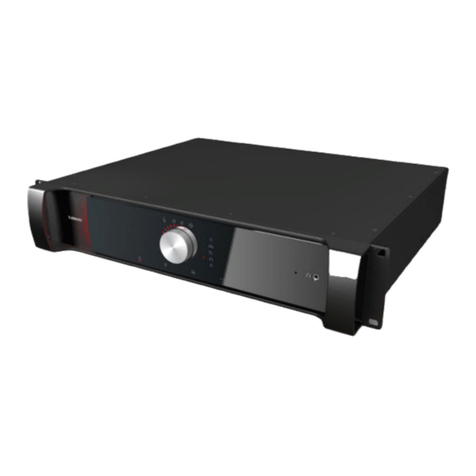
Televic
Televic Plixus Series User manual
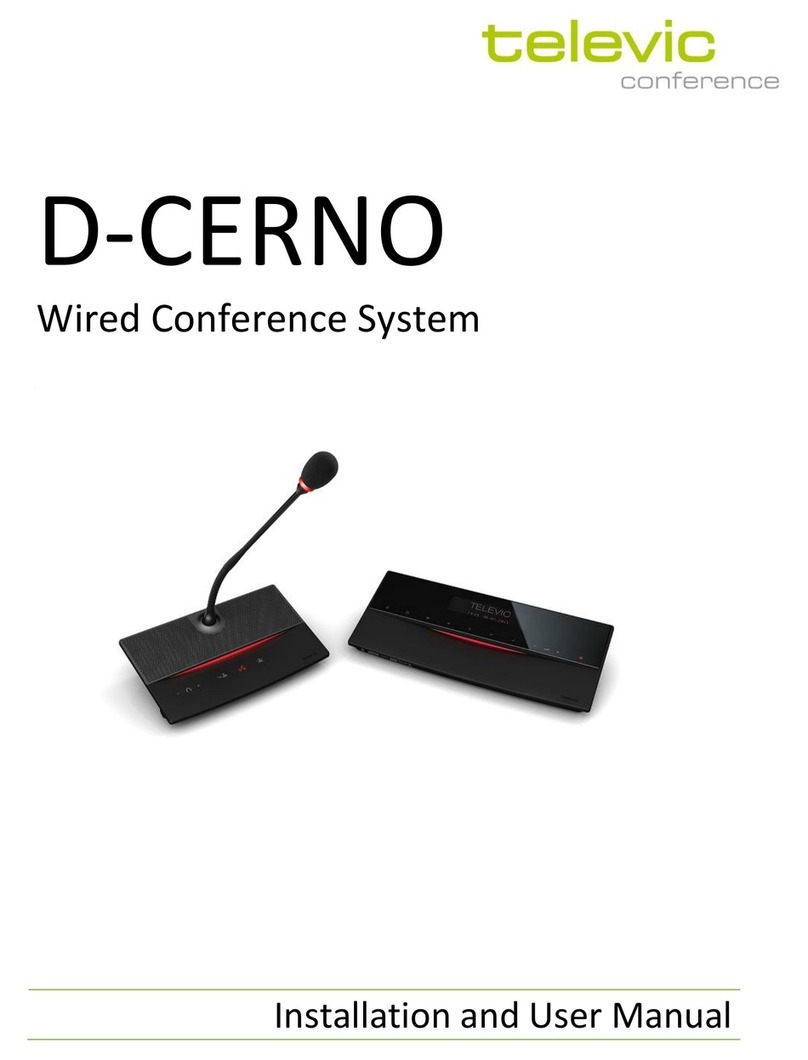
Televic
Televic D-CERNO User manual
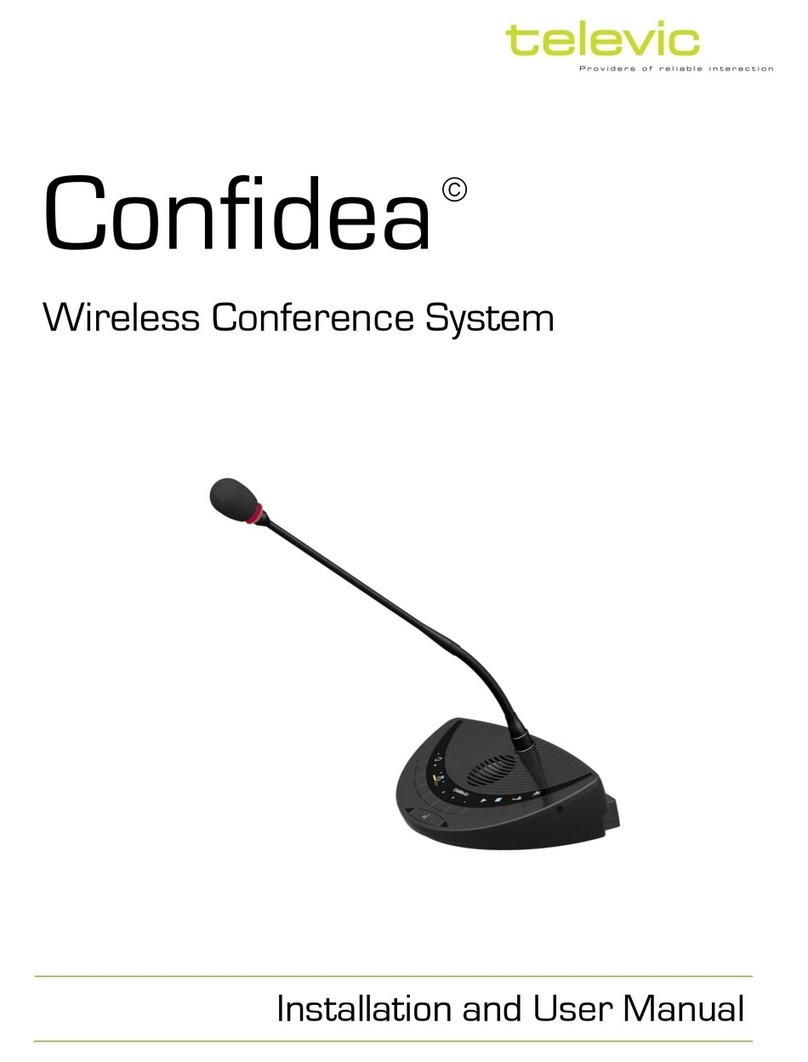
Televic
Televic Confidea User manual
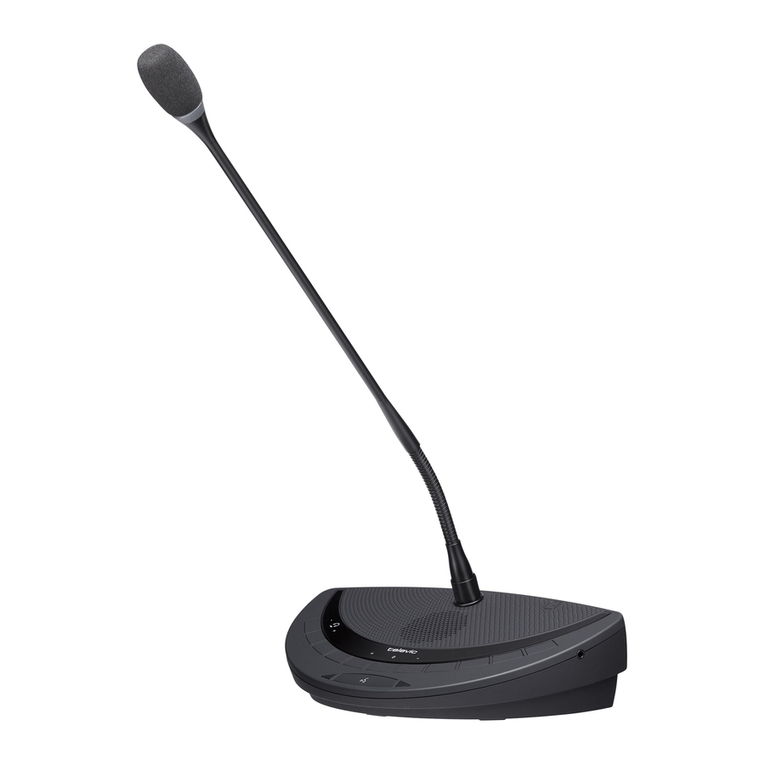
Televic
Televic Confidea G3 User manual

Televic
Televic Confidea Instruction Manual

Televic
Televic Confidea User manual

Televic
Televic D-CERNO User manual

Televic
Televic D-CERNO Instruction manual

Televic
Televic Plixus MME User manual
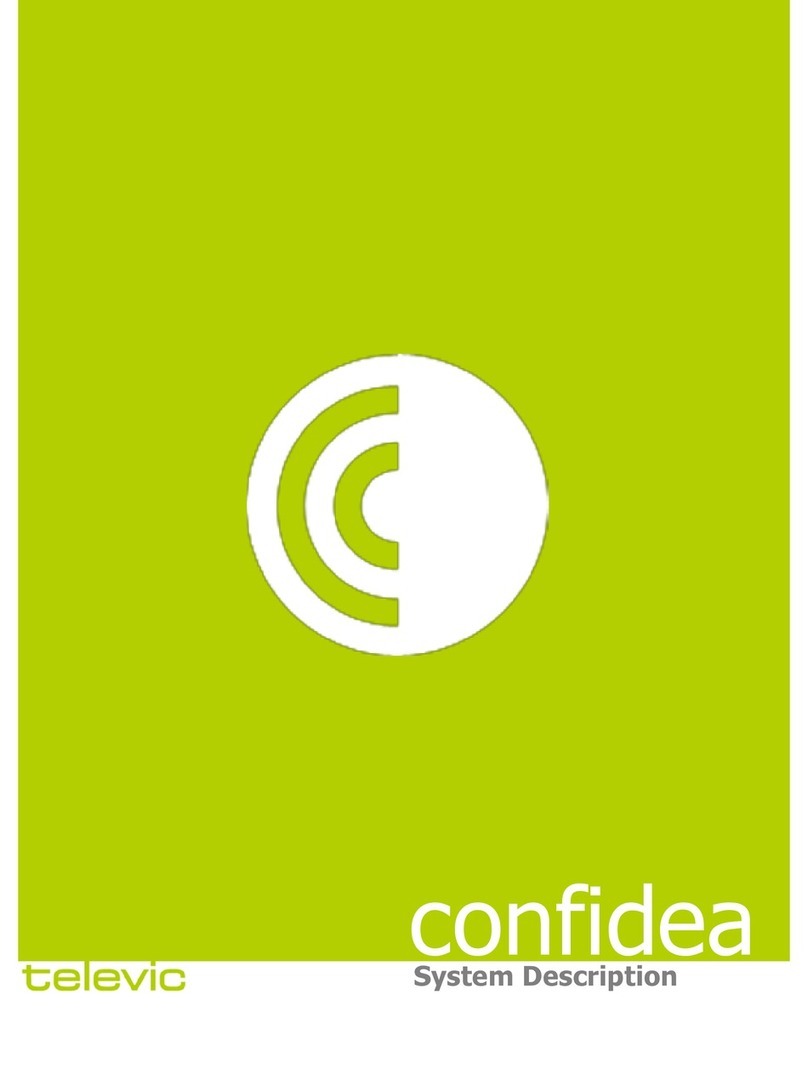
Televic
Televic Confidea DD G3 User guide
